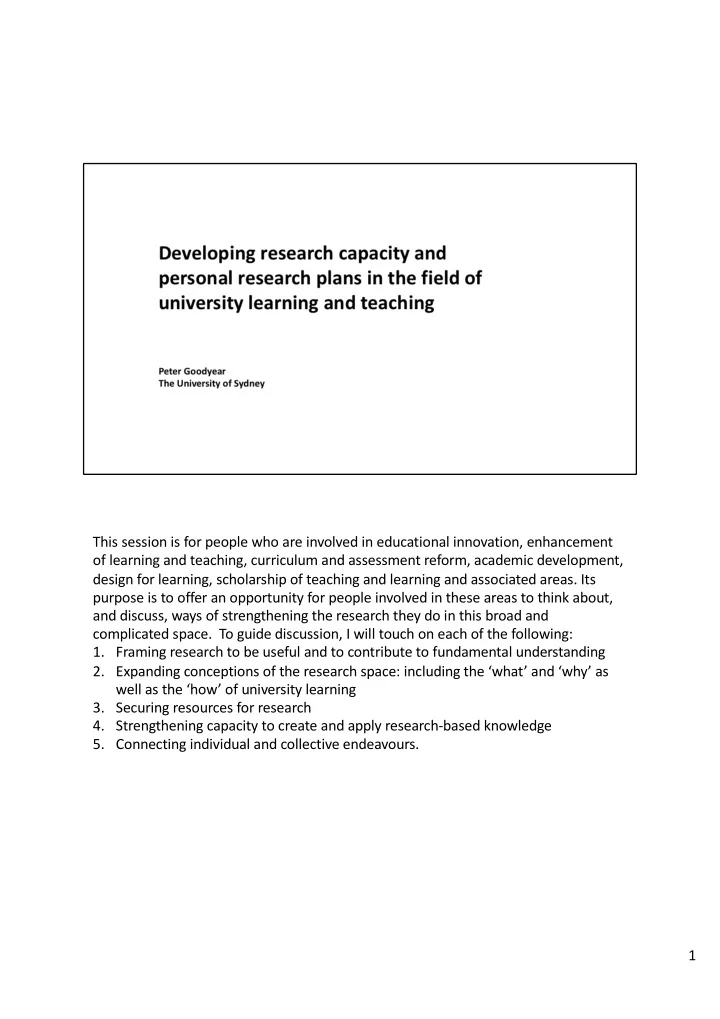

This session is for people who are involved in educational innovation, enhancement of learning and teaching, curriculum and assessment reform, academic development, design for learning, scholarship of teaching and learning and associated areas. Its purpose is to offer an opportunity for people involved in these areas to think about, and discuss, ways of strengthening the research they do in this broad and complicated space. To guide discussion, I will touch on each of the following: 1. Framing research to be useful and to contribute to fundamental understanding 2. Expanding conceptions of the research space: including the ‘what’ and ‘why’ as well as the ‘how’ of university learning 3. Securing resources for research 4. Strengthening capacity to create and apply research-based knowledge 5. Connecting individual and collective endeavours. 1
2
3
Definitions updated as per ABS current consultation on the ANZ standard research classification review. Still based on OECD Frascati manual. Frascati BR = ANZSRC PBR and SBR 4
5
Pasteur’s Quadrant – idea developed in Donald Stokes’ book on academic R&D; brought into ed res debate by Alan Schoenfeld in his 1999 AERA Pres address. Schoenfeld, A. (1999). Looking toward the 21st century: challenges of educational theory and practice. Educational Researcher, 28 (7), 4-14. Stokes, D. (1997). Pasteur's quadrant: basic science and technological innovation . Washington: Brookings Institute. My main point here is about doing work in ‘Pasteur’s Quadrant’ – where utility and fundamental understanding can be combined and where funds/resources intended for specific application-oriented R&D or evaluation can also be used to create more broadly valuable outcomes/outputs. Some centres/depts/units learn to do this well & that this takes an unusual combination of research leadership, strategy & culture. Still a rare talent – not found in many places. It helps one see research excellence and practical impact as complementary rather than in competition. 6
7
8
9
10
11
12
13
14
Markauskaite, L., & Goodyear, P. (2017). Epistemic fluency and professional education: innovation, knowledgeable action and actionable knowledge . Dordrecht: Springer. 15
16
Dr. Ervand Kogbetliantz with his three-dimensional chessboard, New York City, 1952. Yale Joel—The LIFE Picture Collection/Getty Images And https://patentimages.storage.googleapis.com/pages/US3767201-1.png Each game space is a mix of epistemic and productive action (in which one searches for better understanding and tries to make things better) Some of our sharper theoretical ideas about relations between people & technology, individual action and social issues, economy, politics, society, identity etc have been worked out on ‘higher planes’ – in which our professional agency is often quite limited. Knowing which planes/games you can play (at any one time; for any one project) is key Pulling ideas between games can be v useful; mapping connections between game spaces too; spotting moments when one can work in other spaces – all strategically important & part of ‘moral know how’ Such fluency is important for ourselves as educational workers but also important as something we want to help our students develop. But also bear in mind the limits of the metaphor – games spaces & their relations shift; they are undergoing dynamic construction, often by powers outside our control – but not always. 17
18
19
See also Carvalho, L., & Goodyear, P. (2018). Design, learning and service innovation. Design Studies, 55 , 27-53. doi:https://doi.org/10.1016/j.destud.2017.09.003 20
21
22
Recommend
More recommend